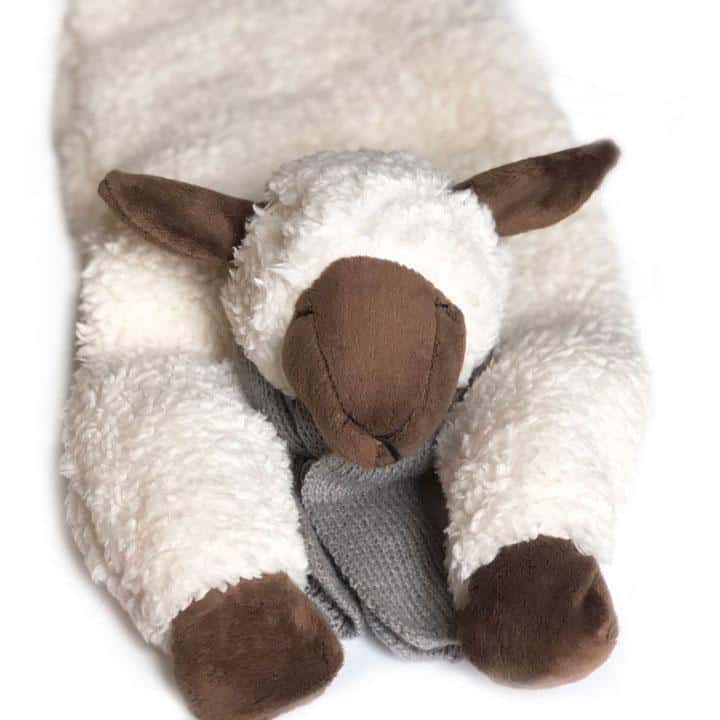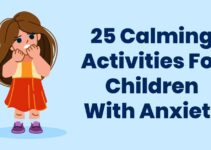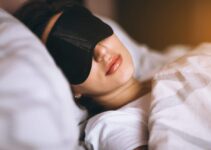Have you ever wondered why a hug from a loved one can make you feel so good? Isn’t it amazing that a physical squeeze can translate to an emotional sense of calm, peace and happiness? That’s exactly why weighted lap pads work so well for mental health purposes.
My name is Daniel. I’m a clinical psychologist in private practice. And in this article, I’m going to speak about weighted lap pads and how they can be used therapeutically by children and adults alike.
Read on as I review 5 top-rated products that are all available online.
But first, what exactly are weighted lap pads?
Table of Contents
- What Are Weighted Lap Pads?
- How Lap Pads Can Be Of Benefit to You and Your Child
- A Selection of Different Types of Lap Pads for Different Needs
- #1. Amazon’s ‘Professional Series’ Weighted Lap Pads (Best for Adults and Adolescents)
- #2. Huggaroo Puppy Weighted Lap Pads (Best Choice for Kids)
- #3. Green Gel Weighted Lap Pads (Best for Hygiene / Easiest to Clean)
- #4. Make Your Own Weighted Lap Pad (Best for DIY)
- #5. Sensa Calm Weighted Lap Pads (Most Customizable)
- Takeaway
What Are Weighted Lap Pads?
Usually made of soft fabric, a lap pad consists of various fabric sections that are joined together. Each section is filled with weighted beads. Think of a soft beanbag the size of a tea tray or small knee rug.
The heavy feel is pleasant to the user; and can be compared to the feeling one gets from a hug or a squeeze, [12]. The separate sections ensure that the weight is evenly distributed which provides immediate comfort as the weight pushes down on one’s lap and wraps around one’s legs.
Weighted lap pads soothe children and adults through evenly distributed tactile pressure that produces sensory integration. This is a neurological process that allows one to return from a state of feeling stressed-out to a calmer state where more appropriate adjustment to the environment and more effective behaviours are possible, [1, 4].
The applications and usefulness of weighted lap pads are extensive. For example, occupational therapists (OTs) have used them effectively for the last 20 years in managing a broad range of psychological conditions Below, we discuss the specific conditions that are likely to benefit.
How Lap Pads Can Be Of Benefit to You and Your Child
Weighted lap pads restore calm and emotional equilibrium to the body.
How does this happen? Through the application of sensory pressure [5]. Experts refer to this as Deep Pressure Touch (DPT) or Deep Pressure Stimulation (DPS) [17].
DPS is incredibly important for children who struggle with sensory overstimulation and neurodevelopmental disorders. It is an essential form of therapy when it comes to regulating emotions and managing behaviour [8].
What are some examples of problems that can be treated by means of weighted lap pads?
- ADHD: when the brain experiences distraction and reduces the capacity for learning, [3]
- Melt-downs and tantrums: overstimulation that is connected to hyper-arousal and aggression, possibly leading to melt-downs and tantrums at home and at school, [5, 13]
- Anxiety: anxiety at school increases the possibility of depression, [3]
- Hyperactivity and poor concentration: which may cause your child to be disruptive in class, [16]
- Anger: unregulated emotions may result in an angry or upset child or poor sleep patterns for babies, [14]
For example, let’s take a look at the hypothetical case of Julio. Julio is a bright and lively school boy, aged 12. He enjoys school and being in class. However, he constantly gets up from his desk, wanders around the classroom and talks to his friends. His teacher finds this annoying and disruptive.
Recently, Julio’s marks have started to drop significantly. On the recommendation of his teacher, Julio’s parents took him to see a pediatrician. Julio was diagnosed with ADHD. He also showed signs of anxiety. Since visiting the doctor, Julio has been receiving medication.
However, the medication did not resolve his symptoms altogether. Although his concentration and hyperactivity were improved, it was still difficult for Julio to function in school.
As a last resort, his parents bought him a weighted lap pad. They found that this helped him to keep calm and stay in his seat for longer. As a result, Julio’s grades slowly started to improve.
Weighted Laps Pads Are Not Only for Children
Let’s look at another hypothetical case of how a lap pad can prove useful, this time in the case of an adult. Marianne (not her real name), is a successful copy-editor. She has diagnoses of Obsessive-Compulsive Disorder (OCD) and Generalized Anxiety. For work, she travels by air to business meetings once a month.
The day before flying, she often struggles to sleep because she is overcome with anxiety. She becomes stressed, irritable and depressed on each trip. In the past she has even missed flights and meetings because she felt too ill or nervous to travel, [3]. Marianne’s boss said she needed to “up her game”.
For an adult like Marianne, a weighted lap pad may prove useful in helping to manage her anxiety. How? This is due to the phenomenon of proprioception: the medical term for being able to be aware of your own body in relation to your environment.
Research [2, 14] has shown that via proprioception, anxiety in adults can be reduced. By using a weighted lap pad while she works, Marianne is able to lower her anxiety levels. This, in turn, helps her to get a good night’s sleep. Together, her improved sleep and reduced anxiety help Marianne to perform better at work during the day.
Some Additional Reasons to Use Weighted Lap Pads
Below, we cover some of the benefits that you (or your child) stand to gain from choosing the right lap pad. This form of therapy is known to be effective when it comes to:
- Reducing insomnia by inducing relaxation
- Improving the capacity to learn by facilitating sensory integration and helping students to concentrate
- Reducing agitation in the elderly
- Reducing anxiety through the process of grounding (i.e. paying attention to your senses in the present moment)
- Overcoming tactile defensiveness (over-sensitivity to touch) in people with Autism [13]
- Reducing feelings of hopelessness that are present in depression [6]
- Reducing PTSD and the disturbing symptoms of Trauma and Post-traumatic Stress Syndrome.
One of the factors that makes lap pads so useful is that they are portable. A lap pad can easily be carried in a hand-held school bag; or kept under one’s desk. They are light, discreet, aesthetic and affordable. However, there are many options to choose from. This article will guide you in choosing the best option for your needs.
Who Stands to Benefit From Weighted Lap Pads?
Weighted lap pads are beneficial for people suffering from a broad range of conditions. So, before we dive into the nitty gritty of how to choose the best weighted lap pad for your needs, let’s look at some of the disorders that may be improved through the use of a lap pad.
Neurodevelopmental Disorders:
- Attention Deficit Hyperactivity Disorder (ADHD) (calming effect)
- Intellectual Disability (ID) (may improve emotional regulation)
- Autism Spectrum Disorder (ASD) (improves sensory integration)
Children with neurodevelopmental disorders such as those mentioned above tend to struggle with sensory processing issues. In other words, the brain struggles to process information that relates to the senses – including touch, sight and smell. Weighted lap pads are great for kids who struggle with sensory processing. You can follow this link to learn more about sensory processing disorder.
Neurocognitive Disorders:
- Depressive Disorders (reduces depression)
- Anxiety Disorders (lowers anxiety levels and helps the person to be more ‘present’)
- Trauma and Stressor-related Disorders (combats feelings of unreality and dis-association)
- Sleep-Wake Disorders (improves sleep patterns)
The Elderly:
- Alzheimer’s Disease (calms and reduces agitation)
- Other forms of Dementia (soothes and encourages sleep)
A Selection of Different Types of Lap Pads for Different Needs
As we have seen, lap pads can be beneficial to people struggling with a broad range of disorders and life challenges. For this reason, weight pads come in many different forms and have been tailored to suit different needs. For example, one can buy:
- Cuddly, soft toy weighted lap pads for small children
- Easy to wash, hygienic weighted lap pads for hospital and clinical use
- Discreet-looking weighted lap pads for use by students, for the office and for travel
- Gel pads in bright colors
- DIY – homemade weighted lap pads, and
- Customizable weighted lap pads that are made-to-order
Let’s Take a Closer Look at What Weighted Lap Pads Look And Feel Like
The Outer Cover and Filling
Although they come in many different shapes and colors, generally weighted lap pads are made of natural fabric or soft fibers such as cotton and fleece that enclose panels of poly-pellets. Some lap pads have a gel filling covered in easy-to wipe, rubbery material. You can shop for hypoallergenic and hygienic lap pads for people with allergies or clinical use.
The Size and Weight
Typically, lap pads are 12 x 18 inches or 12 x 30 inches in size. They should weigh less than 2 Pounds; or between 5% and 10% of a person’s body weight, although there are various sizes and weights available. They should feel snug, comfortable and heavy when used.
What Are my Options and Where Can I Get Weighted Lap Pads From?
Below, we review five popular lap pad options. Use this review to help decide which product best suits your (or your child’s) needs.
#1. Amazon’s ‘Professional Series’ Weighted Lap Pads (Best for Adults and Adolescents)
The Weighted Lap Pad Professional Series is available on Amazon; and this product is made by The Sensory University.
The pluses of this weighted lap pad are that it is:
- Waterproof and machine washable
- Filled with anti-bacterial poly filling
- Good quality for hospital and clinical use, [10]
- Conveniently machine washable
- Relatively inexpensive
- Available in a slate-grey: a suitable color for school, travel and the office
- Manufactured by an established pediatric therapy facility in the USA.
The downside of this product is that it is:
- Limited in terms of available colors and general variety
- Lacking when it comes to a description of the specific sizes and weights of the products
- Fleecy and of a light color, which means that it may pick up stains easily.
The bottom line is that this is lap pad is of a good quality. It is suitable for clinical settings as well as the home, school and office. It is easy to wash and made of grey colored fleecy fabric and is not too expensive.
Click here to see today's price for the lap pad on Amazon
#2. Huggaroo Puppy Weighted Lap Pads (Best Choice for Kids)
Available online, the plus of this weighted lap pad is that it is:
- Soft and pleasant to the touch
- Shaped as a friendly dog, making it toy-like and attractive to children
- Improves relaxation and sleep, encourages emotional regulation and sensory integration.
Drawbacks include:
- The possibility that the child may be scared of the ‘toy dog’ that weighs in at 3.6 pounds, a bit heavier than the recommended weight.
- That this product is comparatively expensive.
The bottom line is that this product is cute and child-friendly – qualities that make it highly suitable for kids. However, this is one of the pricier options
Click here to see today's price for the Huggarro Lap Pad on Amazon
#3. Green Gel Weighted Lap Pads (Best for Hygiene / Easiest to Clean)
The green Weighted Gel Lap Pad is:
- Heat sealed and made with anti-bacterial, phthalate free vinyl which makes it the easiest to wipe clean. This is definitely a hygienic option!
- Suitable to maintain proper infection control
- Filled with non-toxic gel
- Can withstand heavy use: for example, in settings such as schools or hospitals
- Reduces anxiety and hyperactivity; improves focus.
This product is not best-suited for children because:
- It is far bulkier than is recommended for normal use, weighing 5 Pounds
- It is not soft to the touch or aesthetic.
- It comes with a reasonable price tag, at approximately US$50.
The bottom line here is that this is a non-toxic product. It is also hygienic, durable and easy to clean.
Click here to see today's price for the Green Gel Weighted Lap Pad on Amazon
#4. Make Your Own Weighted Lap Pad (Best for DIY)
If you’re a DIY fan, you’ll be pleased to find out that lap pads can be made at home. This may be a viable option, provided that you’re handy with a sewing machine. How does one go about making their own lap pad?
First, you’ll need quilting fabric and / or smooth fusible fleece. You’ll also need approximately 2 Pounds of poly-pellets weighted stuffing beads and your sewing kit. Thereafter, you’ll be ready to go.
Homemade lap pads have the option to provide:
- An inexpensive way of managing a broad array of psychological conditions
- A calming and soothing effect that reduces anxiety and improves sensory integration.
The drawbacks of this DIY option are that it will:
- Require time and effort to sew and make the pad; and to source and supply the filling.
The bottom line is that not everyone enjoys a DIY job. However, this is a great option if you have the time and means to create a healthcare product with a personalized touch. Curious about how exactly one can go about making their own lap pad?
Click here to read step-by-step instructions about making your own weighted lap pads.
#5. Sensa Calm Weighted Lap Pads (Most Customizable)
If you’re not keen on needlework, you can still personalize your lap pad through Sensa Calm’s customizable option.
What are the benefits of this product?
- You can customize your fabric and backing.
- You are able to choose your own color and pattern
- That this is this a great gift idea
- This is a relatively inexpensive product
- Sensa Calm offers soothing and calming effects that provide comfort and warmth as well as reduce symptoms of anxiety.
The one drawback is that:
- It is only available in a single size and weight: 2 Pounds and 12 x 18 inches.
The bottom line is that this product is perfect for those who want to choose their own color, pattern and material. This product makes a great gift and is inexpensive to order
Click here to begin the process of making and designing your weighted lap pad.
Takeaway
A 2017 study carried out at a school on a sample of young people with ASD and ID discovered a new and exciting result. The participants reported increased feelings of happiness when the participants experienced deep pressure. This tells us, using scientific data, that the comforting weight of a lap pad can really improve your quality of life if you struggle with the disorders discussed here [7].
‘Happy hug therapy’ in the form of weighted lap pads can improve your child’s quality of life, as in the case of Julio; and reduce your stress levels just like Marianne. Weighted lap pads make thoughtful gifts and are suitable for everyone, from toddlers to grandparents. With Christmas around the corner, this ‘bear-hug’ can be wrapped and placed under the Christmas tree.
References
- Reed, L. (2017). Sensory-Based Services in Adult Mental Health.
- Ackerly, S. (2001). Studying Sensory Perception: Demonstrating The Sensory-Perceptual Basis For Learning. The Science Teacher, 68(5), 30-34. Retrieved from https://www.jstor.org/stable/24154772
- American Psychiatric Association. (2013). Diagnostic and statistical manual of mental disorders (5th ed.). Arlington, VA: Author.
- Ayres, A. Jean (1974). The Development of Sensory Integrative Theory and Practice: A collection of the works of A. Jean Ayres. Iowa/USA:Kendall/Hunt Pub Co.
- Bakley, S. (2001). Through the Lens of Sensory Integration: A Different Way of Analyzing Challenging Behavior. Young Children, 56(6), 70-76. Retrieved from https://www.jstor.org/stable/42728030
- Berendsen, P. (2017). The Intervention of Touch in Psychotherapy and Trauma Treatment. In Rovers M., Malette J., & Guirguis-Younger M. (Eds.), Touch in the Helping Professions: Research, Practice and Ethics (pp. 85-106). University of Ottawa Press. Retrieved from https://www.jstor.org/stable/j.ctv5vdcvd.9
- Bestbier, L., & Williams, T. I. (2017). The Immediate Effects of Deep Pressure on Young People with Autism and Severe Intellectual Difficulties: Demonstrating Individual Differences. Occupational therapy international, 2017, 7534972. doi:10.1155/2017/7534972
- Chen, H-Y., Chen, H-M, Chi, Yang, H-J. (2011), Physiological Effects of Deep Touch Pressure on Anxiety Alleviation, Journal of Medical and Biological Engineering.
- DiMatties, Marie, E., (n.d.). Understanding sensory integration. LD OnLine: the educator’s guide to learning disabilities and ADHD., Retrieved from https://www.ldonline.org/article/5612/ on 24 November 2018
- Champagne, T, and Stromberg, N. (2004), Sensory Approaches in Inpatient Psychiatric Settings – Innovative Alternatives to Seclusion & Restraint, Journal of Psychosocial Nursing.
- Deep Touch Pressure Research – Autism, ADHD, Sensory Processing Disorders – Tjacket – Non-Weighted Hug Vest That Calms Children, Adults with Anxiety, Autism, ADHD, SPD, PTSD. (n.d). Mytjacket.com, 2017. Retrieved from https://www.mytjacket.com/the-science-behind-it.html.
- Edelson, S M., Goldberg, M., Edelson, Kerr, D.C.R., and Grandin, T. (2017). Behavioral and Physiological Effects of Deep Pressure on Children With Autism: A Pilot Study Evaluating the Efficacy of Grandin’s Hug Machine. (2017). American Journal of Occupational Therapy. American Occupational Therapy Association.
- Myles, B., Dunn, W., Rinner, L., Hagiwara, T., Reese, M., Huggins, A., & Becker, S. (2004). Sensory Issues in Children with Asperger Syndrome and Autism. Education and Training in Developmental Disabilities, 39(4), 283-290. Retrieved from https://www.jstor.org/stable/23880207 on 22 November 2018.
- Occupational Therapy and Sensation. (1999). IJOT: The Israeli Journal of Occupational Therapy / כתב עת ישראלי לריפוי בעיסוק, 8(3), E91-E99. Retrieved from https://www.jstor.org/stable/23463080 on 22 November 2018.
- Rabinoff, E. (2018). The Perceptual Part of the Soul. In Perception in Aristotle’s Ethics (pp. 13-42). Evanston, Illinois: Northwestern University Press. Retrieved from https://www.jstor.org/stable/j.ctv3znz09.5 on 21 November 2018.
- Van den Berg, N.L., (2001), The Use of a Weighted Vest To Increase On-Task Behavior in Children With Attention Difficulties, The American Journal of Occupational Therapy.
- Zissermann, L. (1992). “The Effects of Deep Pressure on Self-Stimulating Behaviors in a Child With Autism and Other Disabilities.” American Journal of Occupational Therapy 46.6 547-51. Web.










